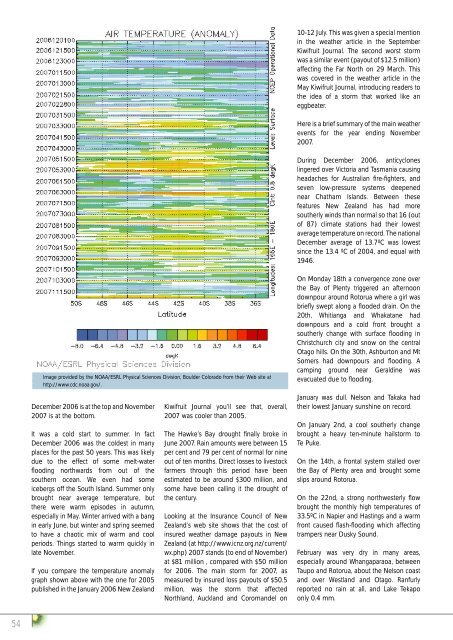Thirsty vines Summer girdling Compost teas Organic marketing The ...
Thirsty vines Summer girdling Compost teas Organic marketing The ...
Thirsty vines Summer girdling Compost teas Organic marketing The ...
Create successful ePaper yourself
Turn your PDF publications into a flip-book with our unique Google optimized e-Paper software.
54<br />
Image provided by the NOAA/ESRL Physical Sciences Division, Boulder Colorado from their Web site at<br />
http://www.cdc.noaa.gov/.<br />
December 2006 is at the top and November<br />
2007 is at the bottom.<br />
It was a cold start to summer. In fact<br />
December 2006 was the coldest in many<br />
places for the past 50 years. This was likely<br />
due to the effect of some melt-water<br />
fl ooding northwards from out of the<br />
southern ocean. We even had some<br />
icebergs off the South Island. <strong>Summer</strong> only<br />
brought near average temperature, but<br />
there were warm episodes in autumn,<br />
especially in May. Winter arrived with a bang<br />
in early June, but winter and spring seemed<br />
to have a chaotic mix of warm and cool<br />
periods. Things started to warm quickly in<br />
late November.<br />
If you compare the temperature anomaly<br />
graph shown above with the one for 2005<br />
published in the January 2006 New Zealand<br />
Kiwifruit Journal you’ll see that, overall,<br />
2007 was cooler than 2005.<br />
<strong>The</strong> Hawke’s Bay drought fi nally broke in<br />
June 2007. Rain amounts were between 15<br />
per cent and 79 per cent of normal for nine<br />
out of ten months. Direct losses to livestock<br />
farmers through this period have been<br />
estimated to be around $300 million, and<br />
some have been calling it the drought of<br />
the century.<br />
Looking at the Insurance Council of New<br />
Zealand’s web site shows that the cost of<br />
insured weather damage payouts in New<br />
Zealand (at http://www.icnz.org.nz/current/<br />
wx.php) 2007 stands (to end of November)<br />
at $81 million , compared with $50 million<br />
for 2006. <strong>The</strong> main storm for 2007, as<br />
measured by insured loss payouts of $50.5<br />
million, was the storm that affected<br />
Northland, Auckland and Coromandel on<br />
10-12 July. This was given a special mention<br />
in the weather article in the September<br />
Kiwifruit Journal. <strong>The</strong> second worst storm<br />
was a similar event (payout of $12.5 million)<br />
affecting the Far North on 29 March. This<br />
was covered in the weather article in the<br />
May Kiwifruit Journal, introducing readers to<br />
the idea of a storm that worked like an<br />
eggbeater.<br />
Here is a brief summary of the main weather<br />
events for the year ending November<br />
2007.<br />
During December 2006, anticyclones<br />
lingered over Victoria and Tasmania causing<br />
headaches for Australian fi re-fi ghters, and<br />
seven low-pressure systems deepened<br />
near Chatham Islands. Between these<br />
features New Zealand has had more<br />
southerly winds than normal so that 16 (out<br />
of 87) climate stations had their lowest<br />
average temperature on record. <strong>The</strong> national<br />
December average of 13.7ºC was lowest<br />
since the 13.4 ºC of 2004, and equal with<br />
1946.<br />
On Monday 18th a convergence zone over<br />
the Bay of Plenty triggered an afternoon<br />
downpour around Rotorua where a girl was<br />
briefl y swept along a fl ooded drain. On the<br />
20th, Whitianga and Whakatane had<br />
downpours and a cold front brought a<br />
southerly change with surface fl ooding in<br />
Christchurch city and snow on the central<br />
Otago hills. On the 30th, Ashburton and Mt<br />
Somers had downpours and fl ooding. A<br />
camping ground near Geraldine was<br />
evacuated due to fl ooding.<br />
January was dull. Nelson and Takaka had<br />
their lowest January sunshine on record.<br />
On January 2nd, a cool southerly change<br />
brought a heavy ten-minute hailstorm to<br />
Te Puke.<br />
On the 14th, a frontal system stalled over<br />
the Bay of Plenty area and brought some<br />
slips around Rotorua.<br />
On the 22nd, a strong northwesterly fl ow<br />
brought the monthly high temperatures of<br />
33.5ºC in Napier and Hastings and a warm<br />
front caused fl ash-fl ooding which affecting<br />
trampers near Dusky Sound.<br />
February was very dry in many areas,<br />
especially around Whangaparaoa, between<br />
Taupo and Rotorua, about the Nelson coast<br />
and over Westland and Otago. Ranfurly<br />
reported no rain at all, and Lake Tekapo<br />
only 0.4 mm.


